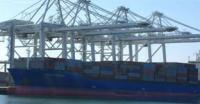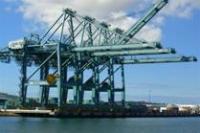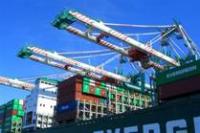[ Previous: Chapter 2 ]
[ Next: Chapter 4 ]
CHAPTER 3 - TERMINAL LEASEHOLDERS
In this section we explain the links between terminal leaseholders and shipping companies either through direct ownership or operating agreements. We provide information related to the general business objectives and strategies of terminal leaseholders. We describe the major difference between the investment company leaseholders in Canada and the shipping company leaseholders in the US.
3.1 - Industry structure
There are two quite different types of marine container terminal owners: 1) shipping companies such as most of those in the US and 2) investment companies such as those in Canada and Mexico. Exhibit 10 depicts the terminal corporate structure and links for these two types of owners:
- Shipping Companies – K-Line (4), China Shipping (3), Hanjin (3), APL-NOL (3), Yang-Ming (2), Hyundai (2), Mitsui OSK (2), NYK (1), Evergreen (3) and Maersk (3); and
- Investment Companies – American Insurance Group (8), Goldman Sachs (4), Hutchison Port Holdings (3), Macquarie Group (3), Ontario Teachers Pension Fund (2), Dubai Ports (1), Grupo TMM (1) and Deutsche Bank (1).
When we first constructed Exhibit 10 in early 2007, there was a separate column for actual terminal operators separate from investment companies. The terminal operators – Maher Terminals, Marine Terminal Corporation, and Stevedoring Services of America – were all independent stevedoring companies with their own strategies and motivations in operating their terminals. These companies serve competing shipping lines and alliances at some of their terminals. However, all of these companies operating on the Pacific Coast of Canada and the US have been purchased by investment companies and are no longer independent.
In the past two years control of container terminal business on the Pacific Coast has consolidated. Approximately two thirds of the leases are now controlled by global shipping companies and the others are controlled by large diversified investment companies. These changes on the Pacific Coast are characteristic of a larger global trend.1 Five years ago most container terminals on the Pacific Coast were leased to labour focused stevedoring companies.
Exhibit 10 - Container Terminal Corporate Relationships in December 20072
The American Insurance Group (AIG), Goldman Sachs, the Ontario Teachers, Macquarie Bank, and Deutsche Bank have purchased Pacific Coast terminal operations of several shipping and stevedoring companies. The container terminal investors seem to be contracting with shipping companies to maintain regular business. Hanjin still has exclusive terminals in Long Beach, Oakland and Seattle, although AIG has purchased a 50 percent interest and Macquarie a 20 percent interest in these terminals. Financial details of these changes are provided in Section 9.
Elsewhere some terminal operating companies are still independent but not on the Pacific Coast of Canada and the US. Hutchison Port Holdings, with terminals in Mexico and Panama, and Dubai Ports (DP) in Canada are not integrated with shipping companies. But they are subsidiaries of multinational organizations more similar to investment companies than to independent stevedoring companies. Both the investment company- and stevedoring company-owned terminal companies have formed joint ventures with major shipping companies to secure business and obtain investment. On the Pacific coast Marine Terminal Corporation and Stevedoring Services of America retain significant control of operations but they are now much less independent.
In Exhibit 10, long-established investment company-owned terminals such as those of Hutchison Port Holdings are shown in the same column as those of more recent investors such as Deutsche Bank’s Maher Terminals and Goldman Sachs’ Stevedoring Services of America. The main difference between the two types of terminal owners is that the shipping company-owned terminals are part of a complete door-to-door service. In practice, the investment company-owned terminals contract their services with specific shipping lines and alliances so the differences become blurred. However, there are significant differences in objectives, service quality, pricing and financial performance as will be discussed in subsequent sections of this report.
In early 2008, shipping companies controlled 21 terminals and investment companies controlled 13 on the Pacific coast. In the US, 21 of the 26 terminals are controlled by shipping companies that compete within each port. The shipping companies provide complete transportation services from the factory gate to the buyers’ warehouses. Three shipping alliances: CKHY, New World, and Grand, and three shipping companies, China Shipping, Maersk and Evergreen control the 21 integrated terminals. The Alliances’ members from several different countries provide reciprocal terminal use rights.
The sizes of the boxes in the first column of Exhibit 10 are proportional to the volume of overall business handled by each of the groups on the Pacific west coast. The volume of business for each shipping company in Vancouver was previously shown in Exhibit 2. The shipping company OOCL, former owner of Vanterm and Deltaport leads in Vancouver but has a relatively small share of US business. CKHY Alliance members K-Line, Hanjin, and Cosco are the next biggest in terms of container volume handled in Vancouver. The company using the largest ships, 6,589 TEUs, Maersk, uses Vanterm in Vancouver. The company has its own terminals in LA, Oakland and Tacoma. It is the only shipping company being considered by the Port of Vancouver as a potential leaseholder for its proposed Terminal 2 project at Roberts Bank.3
There seem to be a few reciprocal agreements between alliance members to use their terminals. For example, the New World Alliance uses the CKHY Alliance’s Pier J North in Long Beach. Evergreen allows the CKHY Alliance to use its Oakland terminal. However, the terminal use is generally stable and ships do not switch terminals.
The CKHY Alliance controls nine of the terminals and shares two terminals, one in Long Beach and one in Oakland with Evergreen Shipping. The Japanese-owned K-Line is the strongest member of the CKHY Alliance with two large terminals in Long Beach and one in Tacoma. Cosco and Hanjin of the CKHY Alliance use Vanterm in Vancouver and Fairview Terminal in Prince Rupert. K-Line and Yang Ming of the CKHY Alliance use Centerm in Vancouver.
The New World Alliance of Singapore-based APL-NOL, Hyundai of Korea and Mitsui OSK (MOL) of Japan controls eight terminals and also uses Centerm in Vancouver. Maersk, Evergreen and China Shipping each control three terminals. The Grand Alliance has had only the Yusen Terminal in Los Angeles but its leading shipper, NYK, recently announced they intend to lease a new $300 million 68 ha container terminal from the Port of Tacoma by 2012.4
The railroads serving the terminals are not shown in Exhibit 10 but are discussed separately in this report. The terminals in Mexico, Panama and at Prince Rupert are served by only one rail line. All the rest are served by two lines and Deltaport is able to use three.
Photos of the largest terminals on the Pacific Coast are provided in Exhibit 11. CKHY Alliance members Hanjin and K-Line operate the largest container terminals in Long Beach. APM-Maersk, APL, and Evergreen Shipping operate the largest terminals in Los Angeles. The Hanjin, APM and APL terminals are new and are very spacious. The large space makes them more efficient than Canadian terminals because there is ample room for containers to be parked on chassis to facilitate convenient truck pick ups.
Long Beach – Total Terminals – Hanjin
Long Beach – Hanjin
Long Beach – ITS, K-Line
Container fork truck
LA – APL on left APM-Maersk on right
LA – China Shipping
LA – Evergreen
LA – Evergreen
The market concentration for the various terminal leaseholders at Pacific Coast ports is shown in the pie charts and data in Exhibit 12. In the US, terminal businesses are diversified with multiple firms competing in most ports. In Canada terminal business is highly concentrated with 60 percent of the import container business handled by a single firm. However, Canada’s terminal business is becoming more competitive with strong gains by Centerm and the start-up of CKHY service at the Prince Rupert this year.
Competition for export business comes from forest products break-bulk terminals, grain elevators and bulk ocean carriers. Container terminals have rapidly gained market share for exports of forest products, barley, peas and lentils. The container terminals are now competitive with the traditional bulk shipments of wheat, canola and oats.
| Terminal Name | Leaseholder | Vancouver | Seattle | Tacoma | Oakland | LB | LA |
|---|---|---|---|---|---|---|---|
| SSA | Goldman | 48 | 14 | 32 | |||
| ITS, TransBay | K-Line | 17 | 8 | 38 | |||
| Maersk | Maersk | 21 | 31 | 18 | |||
| Seaside, Evergreen | AGI | 29 | 14 | 23 | |||
| APL-NOL | APL-NOL | 26 | 10 | 16 | |||
| Delta & Vanterm | OTPP | 65 | |||||
| Total | Hanjin | 26 | 15 | 16 | |||
| Trapac | Mitsui OSK | 8 | 14 | ||||
| W. Basin, Olympic | YM, CS, MTC | 16 | 12 | ||||
| Yusen | NYK | 13 | |||||
| Wash’ton, Cal Un | Hyundai | 14 | |||||
| Hutchison | Hutchison | ||||||
| Centerm | DP World | 35 | |||||
| Washington | Hyundai | 17 | |||||
| Port of LA | 4 | ||||||
| Total | 100 | 100 | 100 | 100 | 100 | 100 |
Our conclusion on reviewing the industry structure and terminal market shares is that terminal ownership by shipping companies gives the US a definite advantage over Canada and Mexico because they have more competitors and competition. Canada uses independent terminal investment companies perhaps with the idea that they have more flexibility to serve multiple shipping lines. In subsequent sections of this report we show that this strategy gives US terminals a service, price, and financial advantage.
3.2 - Leaseholder objectives and strategies
Qualitative information on terminal leaseholders’ objectives and strategies as stated in company financial reports is summarized in Exhibit 13. In general, the integrated shipping companies’ objective is to provide fast, reliable and comprehensive services to their customers. Their strategies to accomplish this include streamlining customers’ distribution networks, increasing vessel operating efficiencies, expanding routes, modernizing equipment, and continually improving their environmental performance.
Exhibit 13 - Objectives and Strategies of Terminal Leaseholders 20076
Shipping Companies
Owner:
CKHY Alliance
Objectives:
- Provide diversified and stable service, reduce costs, and strengthen partnerships
Strategies:
- More effective vessel operations and routes management
- To protect the environment
Owner:
New World Alliance
Objectives:
- Deliver the broadest range of service options and best value for shippers
Strategies:
- Develop new service options
- Effectively deploy new tonnage
- Use collective infrastructure for customers’ benefit
Owner:
China Shipping & ZIM
Objectives:
- Provide fast, reliable, top-quality services
Strategies:
- Expand international routes
- Provide comprehensive services
Owner:
Grand Alliance
Objectives:
- A higher frequency of sailings in fast growing markets
Strategies:
- Efficient deployment plans to reduce fuel consumption and emissions
Owner:
Evergreen Shipping
Objectives:
- Get freight to its destinations safe, secure and just in time
Strategies:
- Streamline customers’ distribution networks
- Better utilize assets and capital
- Keep the earth lush green
Owner:
Maersk
Objectives:
- No loss should hit us that can be avoided with constant care
Strategies:
- Reliable, fast, efficient service
- Door-to-door service with own vessels, containers, terminals, trucks and trains
Investors
Owner:
American Insurance Group
Objectives:
- Provide property and casualty insurance
- Optimize risk-adjusted returns for AIG investors
Strategies:
- Invest to move more cargo through existing footprints
- Superior customer service, innovative technology
- Excellence through training and personal development
Owner:
Goldman Sachs
Objectives:
- Provide superior returns to shareholders
Strategies:
- Broaden reach by upgrading
- Expand services to customers
Owner:
Ontario Teachers Pension Plan
Objectives:
- Generate cash flow for pensions
Strategies:
- Invest in & expand the terminals
Owner:
Deutsche Bank
Objectives:
- Be the leading global provider of financial solutions
- Create value for shareholders
Strategies:
- Grow existing terminal business
- Compete for additional capacity in the North American market
Owner:
Macquarie Bank
Objectives:
- Growth in cash flow
- Invest in long term assets
Strategies:
- Capitalize on expanding trade
- Support existing management
The new generation of terminal leaseholders – investment companies, including pension funds, banks, and private equity investors – are primarily motivated to provide superior returns to their shareholders. They intend to achieve this with superior customer service, higher productivity and innovative technologies. For example, AIG’s stated goal is to provide the capital resources to move more cargo through existing terminal footprints. A representative for Ontario Teachers’ Pension Fund described the terminals as “solid, robust assets, with little vulnerability to market or economic vagaries, and the long term cash flow desired for a pension plan.”7
In comparing the objectives of the two classes of owners, the shipping company-owned terminals appear to be more strongly oriented toward better customer service. However, the investment companies have opened up terminal services to larger shipping companies. For example, change of ownership and major investments in Centerm have attracted the New World Alliance with its larger ships and greater volume of business. Centerm now handles more containers than either Deltaport or Vanterm. Similarly investments at Prince Rupert have attracted the largest shipping group, the CKHY Alliance.
Exhibit 13 shows mainly the highest level objectives, those of the terminal owners. We did not summarize the objectives of the actual operating subsidiaries for each of the terminals. These objectives are more focused on providing high day-to-day service quality. Both classes of terminal owners – the investment companies and the shipping company-owned terminal operating companies – emphasize service quality.
Quantitative data to compare shipping company and financial institution-owned container terminals is provided in subsequent sections of this report. Our analysis indicates that shipping company-owned terminals in the US are achieving their goal of better service but they do not have a price advantage because US local government wharfage, lease rates and property taxes are higher than in Canada.
1 Daniel Olivier, “Private Entry and Emerging Partnerships in Container Terminal Operations: Evidence from Asia”, Maritime Economics & Logistics, July 2005.
3 Port of Vancouver, July 2007. http://www.portvancouver.com/the_port/terminal2.html
4 The News Tribune, September 4, 2007. http://www.thenewstribune.com/business/v-printerfriendly/story/118774.html
5 Source: Calculated by Hanam Canada from Port data
6 Source: Various company Annual Reports.
7 Jim Leech, Senior VP, Teachers’ Private Capital, November 24, 2006. http://www.oocl.com/eng/pressandmedia/pressreleases/2006/24nov06
[ Previous: Chapter 2 ]
[ Next: Chapter 4 ]








